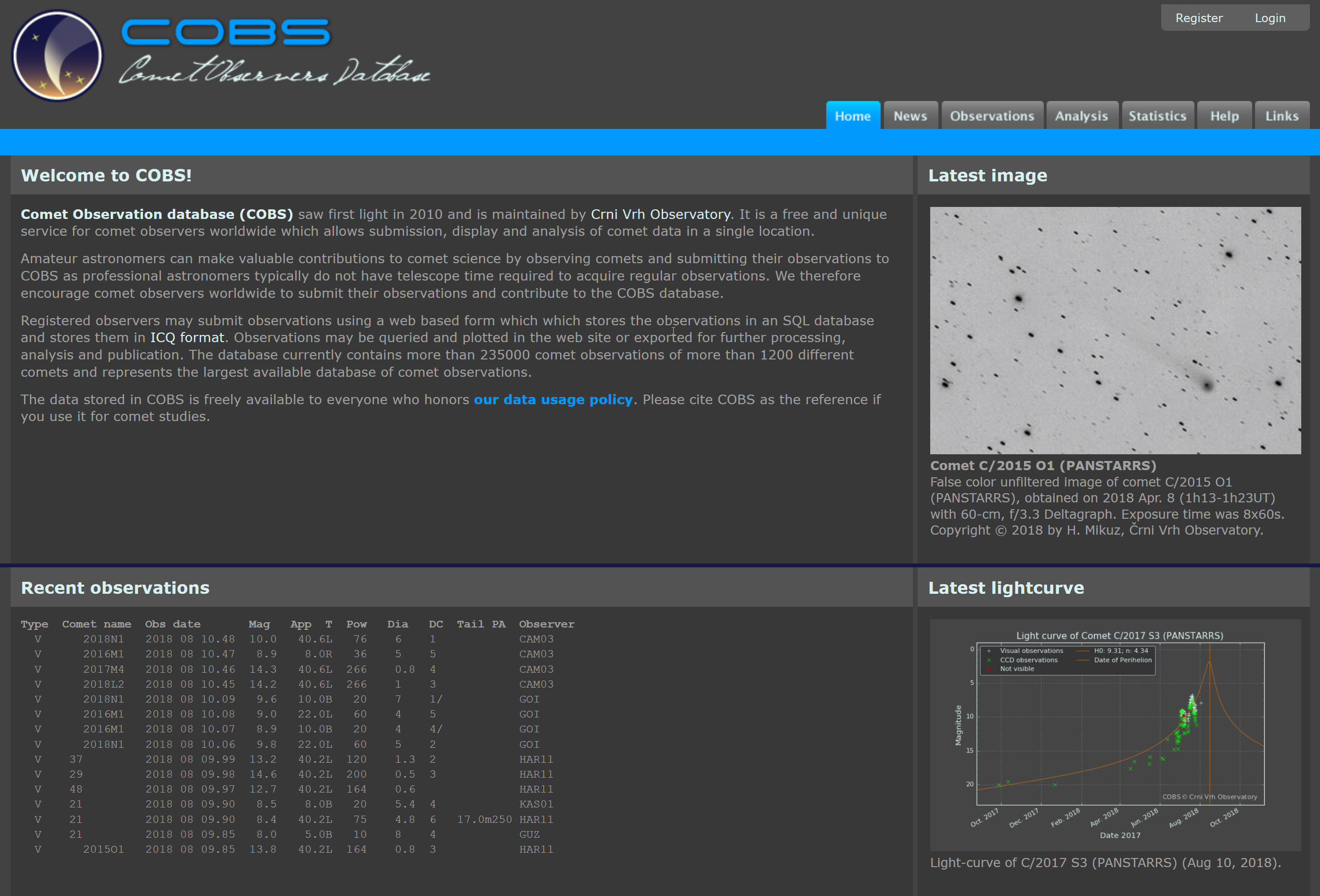The Comet Observation Database - Structure and content (EPSC 2018-632, Berlin 2018)
The Comet Observation Database (COBS) [1, 2] is a unique web service that enables comet observers to submit, display and analyse comet data in a single location. The service currently represents one of the largest databases of comet observations (containing more than 235,000 observations) and is available to comet observers worldwide.
Introduction
The goal of every serious comet observer should be to publish the observations, so that they become available for scientific research.
COBS has been very successful in its task and has been widely accepted by the comet observing community. It offers a unique and simple way to store the comet observations in ICQ format [3] by using web forms to guide the observer in the input of the comet observation.
Data stored in the database are freely available to the community and can be processed with online analysis tools or exported as a ICQ formated text file and imported into any other analysis software.
Website platform and development
The COBS website was introduced to the public in May 2010 at the Meeting on Asteroids and Comets in Europe (MACE) held in Višnjan (Croatia). It is maintained by the Črni Vrh Observatory [4] team.
The foundation of the website is a PostgreSQL database, which holds all the information about the observers and their observations. The front-end of the webpage was written in the Python programming language. It uses the Apache mod-python library to communicate with the Apache http server which is running on a Linux server to generate the dynamic page content.
The current website enables the user to choose between dark or light colour themes. The website layout is presented in Figure 1.
COBS has taken on the task of providing new ICQ-style observer codes and abbreviation keys, as the ICQ has not operated for a number of years. New observers will be assigned a unique observer code when creating an account. The observer code is required for observation submission.
Import of archive observations
A number of associations of comet observers have imported their observation archive to the COBS database. The complete archive of SMPH (Czech Republic) was imported in 2011 followed by the import of VdS (Germany), DCV/NKV (Netherlands), SAAF (Sweden), REA (Brazil), BAA (United Kingdom) and ALPO (USA) archives in 2015.
In January 2016, an import of the available ICQ archive was completed. This archive contained the data submitted to ICQ headquarters up to the year 2009 and contained over 160,000 observations, dating back to 1930. The cumulative number of observations stored in the COBS database through the years, with major imports marked, is presented on Figure 2.
Figure 2: Cumulative number of observations in the COBS database through the years. Major association archive imports are marked.
Database statistics
Currently there are more than 2,500 registered observers in the database, representing 68 different countries all over the world. Almost 90 % of these observers have contributed observations to COBS.
The database stores more than 235,000 visual and photometric (mainly CCD) observations of more than 1200 different comets dating back to 1884. More than 85 % of the submitted observations are visual. On average, more than 400 new observations are currently submitted to the database each month.
| Observed comets: (1,208) | Total | Visual | CCD |
|---|---|---|---|
| Short-period comets: (320) | 82,240 | 69,046 | 13,194 |
| One-apparition Short-period comets: (149) | 2,067 | 1,180 | 887 |
| Long-period comets: (738) | 150,809 | 133,810 | 16,999 |
The best observed comet in the database is C/1995 O1 (Hale-Bopp), with over 15,600 observations. Observations of many short-period comets cover more than just one perihelion passage. Among them 29P/Schwassmann-Wachmann and 1P/Halley have the most observations available in the database.
The number of observations for different comet types is presented in Table 1. The majority of all observations are of long-period comets, followed by short-period comets.
Data usage policy
The COBS Comet Observation Database is the product of the ongoing efforts and expertise of the observers who contribute the data and the COBS technical staff who prepare and maintain the database.
In the publication of results obtained by using COBS, we appeal that users adhere to our data usage policy that can be accessed on the help page. Doing so indicates that you support the purpose of COBS and respect the worldwide community of observers who provided the data.
Summary and Conclusions
The Comet Observation Database (COBS) is currently one of the largest databases of comet observations and is open to comet observers worldwide. The service has been widely accepted and is used by major associations of comet observers, as well as individual observers.
Acknowledgments
The authors are grateful for the assistance given by Jakub Černý, for his engagement and suggestions for new features that helped evolve COBS during the past years.
References
- COBS database. Available at: https://www.cobs.si
- Zakrajšek, J. and Mikuž, H.: Comet Observation database (COBS), BAA Journal (accepted for publication)
- International Comet Quarterly. Available at: http://www.icq.eps.harvard.edu/index.html
- Črni Vrh Observatory. Available at: http://www.observatorij.org
- Warell, J., Zakrajšek, J. and Mikuž, H.: The Comet Observation Database: Observer tools and case study. European planetary Science Congress 644, 2018

